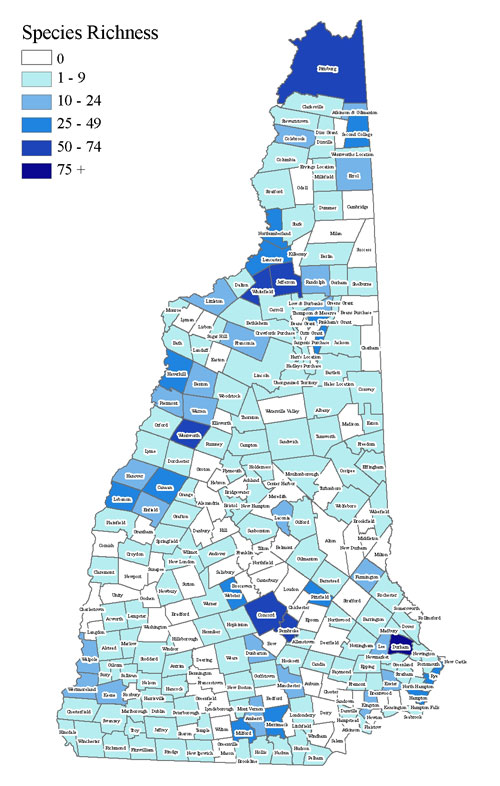
NHA identified significant sources of data on butterfly distribution in the state, including active collectors and photographers, regional experts, and museum collections. Over 8,400 records of 124 species were compiled. Data were compiled for 172 towns, leaving 87 without any records at all. Species richness by county ranged from 21 – 88, with Merrimack County having the most species. Species richness by town ranged from 0 – 78, with high concentrations of species from Durham, Jefferson, Concord, Pittsburg and Whitefield. Clouded Sulphur had the most records (377). Other species with more than 200 records included White Admiral, Cabbage White, Hobomok Skipper, Atlantis Fritillary, Canadian Tiger Swallowtail, Common Ringlet, American Copper and Spring Azure.
In addition to the six species of greatest conservation need already known in New Hampshire, over twenty additional butterfly species were noted as potentially being rare in the state. Three species currently listed as State Historical by New Hampshire Natural Heritage Bureau are likely still present in New Hampshire: Bog Elfin, Juniper Hairstreak and Silvery Checkerspot. The results of this project may be helpful as a starting point to evaluate which butterfly species not currently tracked should be considered for some level of conservation status in New Hampshire. However due to insufficient data for most New Hampshire species it may be more practical to continue data collection and quality control of existing data before making a complete evaluation of conservation status.
Although a significant number of species of butterfly were documented as part of this project, their known distributions are incompletely understood. There are species that are easy to identify, habitat generalists, and known to be common in the state that have spotty distribution maps based on data compiled for this project. The entire State of New Hampshire should be surveyed to obtain more complete information on butterfly distribution. However, there are certain areas of the state lacking in data that should be targeted during any future efforts. The southern Dartmouth / Lake Sunapee Region, the Lakes Region, eastern Monadnock region, southern Seacoast Region and the eastern White Mountains Region are all currently lacking data. In addition, species that are identified as those of potential conservation concern should be evaluated to determine if their associated habitats should be the focus of any future butterfly research in New Hampshire.
NHA is currently seeking funding for a five-year statewide butterfly survey in New Hampshire. This project would be similar in structure to the recently completed New Hampshire Dragonfly Survey. If you have records of butterflies you have seen in New Hampshire, consider entering them on eButterfly, an international, data driven project dedicated to butterfly biodiversity, conservation and education (www.ebutterfly.ca). New Hampshire is currently a “hole” in the knowledge of butterfly distribution in New England and neighboring Canada. Connecticut, Massachusetts, and Vermont have all completed multi-year butterfly survey projects, and two additional survey efforts are currently underway in Maine and the Canadian Maritimes. A multi-year butterfly survey effort in New Hampshire would not only result in a more complete baseline data for the state but would complete the regional snapshot of butterfly numbers, distribution and species status for New England and beyond.
Thanks to all the individuals and organizations that provided data for this project. Funding for this project was provided by the U.S. Fish and Wildlife Service’s State Wildlife Grants program, through a contract between New Hampshire Audubon and the Nongame and Endangered Wildlife Program of the New Hampshire Fish and Game Department. Additional funding was obtained in the form of individual cash donations to the project.
- ConservationOur work falls into several broad catergories:Bald EaglePeregrine FalconNorthern HarrierCommon NighthawkSwallows, Martins and SwiftsWhip-poor-willsGrassland BirdsRusty Blackbird ResearchAmerican PipitsCoastal ShorebirdsThe State of the BirdsMotusFarrar Farm Wildlife Crossing ProjectDragonflies and DamselfliesPollinatorsPollinator Habitat RestorationPhenological Monitoring ProjectRaptor Migration
- Education
- Policy
- Lands
- Centers and EventsCentersEvents
- About Us
